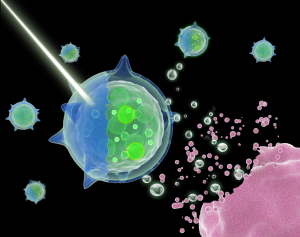A research team led by Wang Ruibing, associate professor in the Institute of Chinese Medical Sciences (ICMS), University of Macau (UM), recently proposed a new strategy to alleviate tumour hypoxia via the photosynthesis of chlorella (Chl), a genus of green algae. In the study, the surface-engineered Chl developed by the team accumulated in tumour issues and modulated the multidrug resistance and immune escape behaviour of tumours through tumour oxygenation, which enhanced the antitumour efficacy of first-line clinical drugs. The research result has been published in the top international journal Materials Today.
Rapid tumour growth causes increased oxygen consumption and diffusion, resulting in a low oxygen transport efficiency and an associated hypoxic microenvironment in the tumour. It also upregulates the expression of glucose transporters and their downstream proteins, inducing drug efflux and drug resistance in tumour tissues. Meanwhile, the hypoxic microenvironment also activates the adenosine pathway, which enhances the immune escape of tumour cells and weakens the efficacy of immunotherapy. Therefore, if the hypoxic microenvironment is oxygenated, the poor antitumour performance of chemotherapeutic and immunotherapy drugs could be improved to a certain extent. The common strategies to improve the hypoxic microenvironment of tumours are to directly deliver oxygen to the tumour with nanocarriers, or to use enzymes to catalyse the conversion of local hydrogen peroxide into oxygen in the tumour. However, these methods could only transiently supply oxygen and cannot effectively change the tumour’s hypoxia-related histopathological features.
Chl is a common genus of green algae with various health benefits and medicinal values. It can supplement the essential nutrients of the human body, and can enhance immunity, lower blood lipids, and remove toxins. Titled ‘Surface-engineered Chlorella Alleviated Hypoxic Tumour Microenvironment for Enhanced Chemotherapy and Immunotherapy of First-line Drugs’, the study proposes a new strategy to supply oxygen to tumours using the oxygen-producing Chl. Surface-engineered Chl, or Chl coated with macrophage membranes (M-Chl), can escape the clearance of the immune system and accumulate in tumor tissues in response to inflammatory signals. The study shows that the continuous oxygen production of M-Chl under irradiation can improve the hypoxic microenvironment of the tumour and inhibit the expression of drug efflux-related proteins as well as immunosuppression-related proteins. Therefore, M-Chl treatment can significantly improve the therapeutic efficacy of first-line clinical drugs for chemotherapy and immunotherapy and has the potential to be used as an adjuvant for clinical anti-tumour therapies.
Prof Wang is the lead corresponding author of the paper and ICMS Distinguished Professor Lee Ming Yuen is the co-corresponding author. UM Macao Postdoctoral Fellow Gao Cheng and PhD student Cheryl Kwong are the co-first authors. UM MSc student Qingfu Wang, UM PhD students Hiotong Kam and Qian Chen, UM Research Assistant Jianwen Wei, as well as Dr. Jian Zhang and Dr. Dayong Gu from Shenzhen Second People’s Hospital, also made important contributions to this work. The project was funded by Dr Stanley Ho Medical Development Foundation (File no: SHMDF-OIRFS/2021/002), Shenzhen Science and Technology Innovation Commission (File no: SGDX20210823103803027), the National Natural Science Foundation of China (File no: 32001016), and the Ministry of Education Frontiers Science Center for Precision Oncology, UM.
To view the full-version of the paper, please visit:
https://doi.org/10.1016/j.mattod.2022.06.024
| Source: Institute of Chinese Medical Sciences | |
| Media Contact Information: | |
| Communications Office, University of Macau | |
| Albee Lei | Tel: (853) 8822 8004 |
| Cathy Cheang | Tel: (853) 8822 8009 |
| Email: | prs.media@um.edu.mo |


